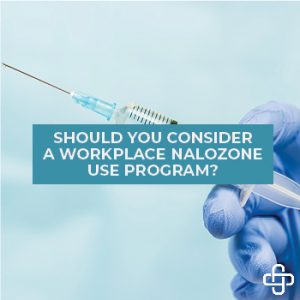 Opioid misuse and overdose deaths from opioids are serious health issues in the United States. Overdose deaths involving prescription and illicit opioids doubled from 2010 to 2016, with more than 42,000 deaths in 2016.
Opioid misuse and overdose deaths from opioids are serious health issues in the United States. Overdose deaths involving prescription and illicit opioids doubled from 2010 to 2016, with more than 42,000 deaths in 2016.
Anyone at a workplace, including workers, clients, customers, and visitors, is at risk of overdose if they use opioids.
As overdose without immediate intervention can quickly lead to death, many workplaces are considering having naloxone available in the workplace. This drug would be administered after calling 911 for assistance.
What is Naloxone?
Naloxone hydrochloride (also known as naloxone, NARCAN® or EVZIO®) is a drug that can temporarily stop many of the life-threatening effects of overdoses from opioids.
Naloxone can help:
- Restore breathing.
- Reverse the sedation and unconsciousness that are common during an opioid overdose.
Workplace Naloxone Considerations
Before implementing a workplace naloxone program, the National Institute for Occupational Safety and Health (NIOSH) recommends the following considerations:
- Does the state where your workplace is located allow the administration of naloxone by non-licensed providers in the event of an overdose emergency?
- What liability and legal considerations should be addressed? Does your state’s Good Samaritan law cover emergency naloxone administration?
- Do you have staff willing to be trained and willing to provide naloxone?
- Has your workplace experienced an opioid overdose or has there been evidence of opioid drug use onsite (such as finding drugs, needles or other paraphernalia)?
- How quickly can professional emergency response personnel access your workplace to provide assistance?
- Does your workplace offer other first aid or emergency response interventions (first aid kits, AEDs, trained first aid providers)? Can naloxone be added?
- Are the risks for opioid overdose greater in your geographic location? The National Center for Health Statistics provides data on drug overdose deaths in an online state dashboard. [CDC 2018a.]
- Are the risks for opioid overdose greater in your industry or among occupations at your workplace? [See MDPH 2018 and CDC 2018c.]
- Does your workplace have frequent visitors, clients, patients, or other members of the public that may be at increased risk of opioid overdose?
Review the above questions periodically even if a program is not established right away. Ideally, a naloxone program is but a part of a more comprehensive workplace program on opioid awareness and misuse prevention.

Holly is an ER nurse by trade, but loves content marketing. She was born outside the box and believes everything is better with “sprinkles and sparkles”. She is passionate about impacting lives and uses marketing as her platform for sharing practical solutions to address real life occupational health challenges.
Find out more about our Injury Case Management services or our Occupational Health Programs.










